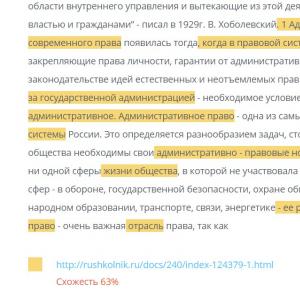Find the equation of a straight line through 2 points. Equation of a straight line passing through two points
This article discloses the derivation of the equation of a straight line passing through two given points in a rectangular coordinate system located on a plane. Let us derive the equation of a straight line passing through two given points in a rectangular coordinate system. We will clearly show and solve several examples related to the passed material.
Before obtaining the equation of a straight line passing through two given points, it is necessary to pay attention to some facts. There is an axiom that says that it is possible to draw a straight line and only one through two non-coinciding points on the plane. In other words, two given points of the plane are defined by a straight line passing through these points.
If the plane is specified by a rectangular coordinate system Oxy, then any straight line depicted in it will correspond to the equation of a straight line on the plane. There is also a connection with the direction vector of the line. This data is enough to make the equation of a line passing through two given points.
Let's consider an example of solving a similar problem. It is necessary to draw up an equation of the straight line a passing through two non-coinciding points M 1 (x 1, y 1) and M 2 (x 2, y 2), which are in the Cartesian coordinate system.
In the canonical equation of a straight line on a plane, which has the form x - x 1 ax \u003d y - y 1 ay, a rectangular coordinate system O x y with a straight line is specified, which intersects with it at a point with coordinates M 1 (x 1, y 1) with a guide vector a → \u003d (ax, ay).
It is necessary to compose the canonical equation of the straight line a, which passes through two points with coordinates M 1 (x 1, y 1) and M 2 (x 2, y 2).
Line a has a direction vector M 1 M 2 → with coordinates (x 2 - x 1, y 2 - y 1), since it intersects points M 1 and M 2. We obtained the necessary data in order to transform the canonical equation with the coordinates of the direction vector M 1 M 2 → \u003d (x 2 - x 1, y 2 - y 1) and the coordinates of the points M 1 (x 1, y 1) lying on them and M 2 (x 2, y 2). We get an equation of the form x - x 1 x 2 - x 1 \u003d y - y 1 y 2 - y 1 or x - x 2 x 2 - x 1 \u003d y - y 2 y 2 - y 1.
Consider the figure below.
Following the calculations, we write down the parametric equations of a straight line on a plane that passes through two points with coordinates M 1 (x 1, y 1) and M 2 (x 2, y 2). We obtain an equation of the form x \u003d x 1 + (x 2 - x 1) λ y \u003d y 1 + (y 2 - y 1) λ or x \u003d x 2 + (x 2 - x 1) λ y \u003d y 2 + (y 2 - y 1) λ.
Let's take a closer look at the solution of several examples.
Example 1
Write down the equation of a straight line passing through 2 given points with coordinates M 1 - 5, 2 3, M 2 1, - 1 6.
Decision
The canonical equation for a straight line intersecting at two points with coordinates x 1, y 1 and x 2, y 2 takes the form x - x 1 x 2 - x 1 \u003d y - y 1 y 2 - y 1. By the condition of the problem, we have that x 1 \u003d - 5, y 1 \u003d 2 3, x 2 \u003d 1, y 2 \u003d - 1 6. Substitute numeric values \u200b\u200binto the equation x - x 1 x 2 - x 1 \u003d y - y 1 y 2 - y 1. From here we get that the canonical equation takes the form x - (- 5) 1 - (- 5) \u003d y - 2 3 - 1 6 - 2 3 ⇔ x + 5 6 \u003d y - 2 3 - 5 6.
Answer: x + 5 6 \u003d y - 2 3 - 5 6.
If you need to solve a problem with a different kind of equation, then first you can go to the canonical, since it is easier to come from it to any other.
Example 2
Draw up the general equation of a straight line passing through points with coordinates M 1 (1, 1) and M 2 (4, 2) in the coordinate system O x y.
Decision
First, you need to write down the canonical equation of a given straight line that passes through two given points. We get an equation of the form x - 1 4 - 1 \u003d y - 1 2 - 1 ⇔ x - 1 3 \u003d y - 1 1.
Let us bring the canonical equation to the required form, then we get:
x - 1 3 \u003d y - 1 1 ⇔ 1 x - 1 \u003d 3 y - 1 ⇔ x - 3 y + 2 \u003d 0
Answer: x - 3 y + 2 \u003d 0.
Examples of such tasks were considered in school textbooks in algebra lessons. School problems were distinguished by the fact that the equation of a straight line with a slope was known, having the form y \u003d k x + b. If you need to find the value of the slope k and the number b for which the equation y \u003d kx + b defines a line in the O x y system that passes through the points M 1 (x 1, y 1) and M 2 (x 2, y 2) , where x 1 ≠ x 2. When x 1 \u003d x 2 , then the slope takes on the value of infinity, and the straight line М 1 М 2 is determined by a general incomplete equation of the form x - x 1 \u003d 0 .
Because the points M 1 and M 2are on the straight line, then their coordinates satisfy the equation y 1 \u003d k x 1 + b and y 2 \u003d k x 2 + b. It is necessary to solve the system of equations y 1 \u003d k x 1 + b y 2 \u003d k x 2 + b for k and b.
To do this, find k \u003d y 2 - y 1 x 2 - x 1 b \u003d y 1 - y 2 - y 1 x 2 - x 1 x 1 or k \u003d y 2 - y 1 x 2 - x 1 b \u003d y 2 - y 2 - y 1 x 2 - x 1 x 2.
With such values \u200b\u200bof k and b, the equation of the straight line passing through the given two points takes the following form y \u003d y 2 - y 1 x 2 - x 1 x + y 2 - y 2 - y 1 x 2 - x 1 x 1 or y \u003d y 2 - y 1 x 2 - x 1 x + y 2 - y 2 - y 1 x 2 - x 1 x 2.
Remembering such a huge number of formulas at once will not work. To do this, you need to increase the number of repetitions in solving problems.
Example 3
Write down the equation of the straight line with the slope passing through the points with coordinates M 2 (2, 1) and y \u003d k x + b.
Decision
To solve the problem, we use a formula with a slope, which has the form y \u003d k x + b. Coefficients k and b should take such a value that this equation corresponds to a straight line passing through two points with coordinates M 1 (- 7, - 5) and M 2 (2, 1).
Points M 1 and M 2 are located on a straight line, then their coordinates should reverse the equation y \u003d k x + b true equality. From this we obtain that - 5 \u003d k (- 7) + b and 1 \u003d k 2 + b. Combine the equation into the system - 5 \u003d k · - 7 + b 1 \u003d k · 2 + b and solve.
Upon substitution, we obtain
5 \u003d k - 7 + b 1 \u003d k 2 + b ⇔ b \u003d - 5 + 7 k 2 k + b \u003d 1 ⇔ b \u003d - 5 + 7 k 2 k - 5 + 7 k \u003d 1 ⇔ ⇔ b \u003d - 5 + 7 kk \u003d 2 3 ⇔ b \u003d - 5 + 7 2 3 k \u003d 2 3 ⇔ b \u003d - 1 3 k \u003d 2 3
Now the values \u200b\u200bk \u003d 2 3 and b \u003d - 1 3 are substituted into the equation y \u003d k x + b. We get that the required equation passing through the given points will be an equation of the form y \u003d 2 3 x - 1 3.
This way of solving it predetermines the waste of a lot of time. There is a way in which the task is solved literally in two steps.
We write the canonical equation of the line passing through M 2 (2, 1) and M 1 (- 7, - 5), which has the form x - (- 7) 2 - (- 7) \u003d y - (- 5) 1 - (- 5) ⇔ x + 7 9 \u003d y + 5 6.
We now turn to the equation in the slope. We get that: x + 7 9 \u003d y + 5 6 ⇔ 6 (x + 7) \u003d 9 (y + 5) ⇔ y \u003d 2 3 x - 1 3.
Answer: y \u003d 2 3 x - 1 3.
If in three-dimensional space there is a rectangular coordinate system O x y z with two given non-coinciding points with coordinates M 1 (x 1, y 1, z 1) and M 2 (x 2, y 2, z 2), the straight line M 1 M 2, it is necessary to obtain the equation of this straight line.
We have that canonical equations of the form x - x 1 ax \u003d y - y 1 ay \u003d z - z 1 az and parametric equations of the form x \u003d x 1 + ax λ y \u003d y 1 + ay λ z \u003d z 1 + az λ are able to set a line in the O x y z coordinate system passing through the points having coordinates (x 1, y 1, z 1) with the direction vector a → \u003d (ax, ay, az).
Straight M 1 M 2 has a direction vector of the form M 1 M 2 → \u003d (x 2 - x 1, y 2 - y 1, z 2 - z 1), where the line passes through the point M 1 (x 1, y 1, z 1) and M 2 (x 2, y 2, z 2), hence the canonical equation can be of the form x - x 1 x 2 - x 1 \u003d y - y 1 y 2 - y 1 \u003d z - z 1 z 2 - z 1 or x - x 2 x 2 - x 1 \u003d y - y 2 y 2 - y 1 \u003d z - z 2 z 2 - z 1, in turn parametric x \u003d x 1 + (x 2 - x 1) λ y \u003d y 1 + (y 2 - y 1) λ z \u003d z 1 + (z 2 - z 1) λ or x \u003d x 2 + (x 2 - x 1) λ y \u003d y 2 + (y 2 - y 1) Λ z \u003d z 2 + (z 2 - z 1) λ.
Consider a figure that shows 2 given points in space and the equation of a straight line.

Example 4
Write the equation of a straight line defined in a rectangular coordinate system O x y z of three-dimensional space passing through two given points with coordinates M 1 (2, - 3, 0) and M 2 (1, - 3, - 5).
Decision
It is necessary to find the canonical equation. Since we are talking about three-dimensional space, it means that when a straight line passes through given points, the desired canonical equation takes the form x - x 1 x 2 - x 1 \u003d y - y 1 y 2 - y 1 \u003d z - z 1 z 2 - z 1 ...
By hypothesis, we have that x 1 \u003d 2, y 1 \u003d - 3, z 1 \u003d 0, x 2 \u003d 1, y 2 \u003d - 3, z 2 \u003d - 5. Hence it follows that the necessary equations can be written as follows:
x - 2 1 - 2 \u003d y - (- 3) - 3 - (- 3) \u003d z - 0 - 5 - 0 ⇔ x - 2 - 1 \u003d y + 3 0 \u003d z - 5
Answer: x - 2 - 1 \u003d y + 3 0 \u003d z - 5.
If you notice an error in the text, please select it and press Ctrl + Enter
Let's consider how to draw up the equation of a straight line passing through two points using examples.
Example 1.
Make the equation of the straight line passing through the points A (-3; 9) and B (2; -1).
Method 1 - compose the equation of a straight line with a slope.
The equation of a straight line with a slope has the form. Substituting the coordinates of points A and B into the equation of the straight line (x \u003d -3 and y \u003d 9 - in the first case, x \u003d 2 and y \u003d -1 - in the second), we obtain a system of equations from which we find the values \u200b\u200bof k and b:
Adding the 1st and 2nd equations term by term, we get: -10 \u003d 5k, whence k \u003d -2. Substituting k \u003d -2 into the second equation, we find b: -1 \u003d 2 · (-2) + b, b \u003d 3.
Thus, y \u003d -2x + 3 is the desired equation.
Method 2 - compose the general equation of the straight line.
The general equation of the straight line is. Substituting the coordinates of points A and B into the equation, we get the system:
Since the number of unknowns is greater than the number of equations, the system is not solvable. But you can express all the variables through one. For example, through b.
Multiplying the first equation of the system by -1 and adding term by term with the second:
we get: 5a-10b \u003d 0. Hence a \u003d 2b.
Substitute the resulting expression into the second equation: 2 · 2b -b + c \u003d 0; 3b + c \u003d 0; c \u003d -3b.
Substitute a \u003d 2b, c \u003d -3b into the equation ax + by + c \u003d 0:
2bx + by-3b \u003d 0. It remains to split both parts by b:
The general equation of a straight line is easily reduced to the equation of a straight line with a slope:
Method 3 - compose the equation of a straight line passing through 2 points.
The equation of a straight line passing through two points has:
![]()
Substitute into this equation the coordinates of points A (-3; 9) and B (2; -1)
(that is, x 1 \u003d -3, y 1 \u003d 9, x 2 \u003d 2, y 2 \u003d -1):
![]()
and simplify:
whence 2x + y-3 \u003d 0.
In the school course, the equation of a straight line with a slope is most often used. But the easiest way is to derive and use the formula for the equation of a straight line passing through two points.
Comment.
If, when substituting the coordinates of the given points, one of the denominators of the equation
![]()
turns out to be equal to zero, then the desired equation is obtained by equating to zero of the corresponding numerator.
Example 2.
Make an equation of a straight line passing through two points C (5; -2) and D (7; -2).
We substitute the coordinates of points C and D into the equation of a straight line passing through 2 points.
Let the line pass through the points M 1 (x 1; y 1) and M 2 (x 2; y 2). The equation of the straight line passing through the point M 1 has the form y-y 1 \u003d k (x - x 1), (10.6)
where k - still unknown coefficient.
Since the straight line passes through the point M 2 (x 2 y 2), the coordinates of this point must satisfy the equation (10.6): y 2 -y 1 \u003d k (x 2 -x 1).
From here we find Substituting the found value k
into equation (10.6), we obtain the equation of a straight line passing through points M 1 and M 2: 
It is assumed that in this equation x 1 ≠ x 2, y 1 ≠ y 2
If x 1 \u003d x 2, then the straight line passing through the points M 1 (x 1, y I) and M 2 (x 2, y 2) is parallel to the ordinate axis. Its equation has the form x \u003d x 1 .
If y 2 \u003d y I, then the equation of the straight line can be written as y \u003d y 1, the straight line M 1 M 2 is parallel to the abscissa axis.
Equation of a straight line in segments
Let the straight line intersect the Ox axis at the point M 1 (a; 0), and the Oy axis - at the point M 2 (0; b). The equation will take the form:  those.
those.  ... This equation is called the equation of a straight line in segments, since the numbers a and b indicate which segments are cut off by a straight line on the coordinate axes.
... This equation is called the equation of a straight line in segments, since the numbers a and b indicate which segments are cut off by a straight line on the coordinate axes.

Equation of a straight line passing through a given point perpendicular to a given vector
Let us find the equation of a straight line passing through a given point Mo (x O; y o) perpendicular to a given nonzero vector n \u003d (A; B).
Take an arbitrary point M (x; y) on a straight line and consider the vector M 0 M (x - x 0; y - y o) (see Fig. 1). Since the vectors n and M o M are perpendicular, their scalar product is zero: that is
A (x - xo) + B (y - yo) \u003d 0. (10.8)
Equation (10.8) is called the equation of a straight line passing through a given point perpendicular to a given vector .
The vector n \u003d (A; B), perpendicular to the straight line, is called normal the normal vector of this line .
Equation (10.8) can be rewritten as Ax + Wu + C \u003d 0 , (10.9)
where A and B are the coordinates of the normal vector, C \u003d -Aх о - Ву о - free term. Equation (10.9) is the general equation of the straight line (see fig. 2).

Fig. 1 Fig. 2
Canonical equations of the line
 ,
,
Where  - coordinates of the point through which the straight line passes, and
- coordinates of the point through which the straight line passes, and  - direction vector.
- direction vector.
Second-order Curves Circle
A circle is the set of all points of the plane, equidistant from a given point, which is called the center.
The canonical equation of a circle of radius
R centered at point  :
:
In particular, if the center of the stake coincides with the origin, then the equation will look like: 
Ellipse
An ellipse is a set of points on a plane, the sum of the distances from each of which to two given points
 and
and  , which are called foci, are constant
, which are called foci, are constant  greater than the distance between the foci
greater than the distance between the foci  .
.
The canonical equation of an ellipse, the foci of which lie on the Ox axis, and the origin of coordinates midway between the foci has the form  r
r  dea the length of the semi-major axis;b - the length of the semi-minor axis (Fig. 2).
dea the length of the semi-major axis;b - the length of the semi-minor axis (Fig. 2).
Relationship between ellipse parameters
 and
and  expressed by the ratio:
expressed by the ratio:
 (4)
(4)
Eccentricity ellipsecalled the ratio of the interfocal distance2c to the major axis2a:
Directors
ellipses are called straight lines parallel to the axis Oy, which are at a distance from this axis. Directrix equations:  .
.
If in the ellipse equation  , then the foci of the ellipse are on the Oy axis.
, then the foci of the ellipse are on the Oy axis.
So, 

Let two points be given M 1 (x 1, y 1) and M 2 (x 2, y 2)... We write the equation of the straight line in the form (5), where k still unknown coefficient:
Since the point M 2belongs to a given straight line, then its coordinates satisfy equation (5):. Expressing from this and substituting it into equation (5) we obtain the desired equation:
![]()
If ![]() this equation can be rewritten in a form more convenient for memorization:
this equation can be rewritten in a form more convenient for memorization:
![]() (6)
(6)
Example.Write down the equation of the straight line passing through the points M 1 (1.2) and M 2 (-2.3)
Decision. ![]() ... Using the property of proportion, and performing the necessary transformations, we obtain the general equation of the straight line:
... Using the property of proportion, and performing the necessary transformations, we obtain the general equation of the straight line:
Angle between two straight lines
Consider two lines l 1 and l 2:
l 1:,, and
l 2: , ,
φ is the angle between them (). Figure 4 shows:.
 |
From here ![]() , or
, or
Using formula (7), one of the angles between the straight lines can be determined. The second angle is.
Example... Two straight lines are given by the equations y \u003d 2x + 3 and y \u003d -3x + 2. find the angle between these lines.
Decision... From the equations it can be seen that k 1 \u003d 2, and k 2 \u003d -3. substituting these values \u200b\u200binto formula (7), we find
![]() ... Thus, the angle between these lines is equal.
... Thus, the angle between these lines is equal.
Conditions for parallelism and perpendicularity of two lines
If straight l 1 and l 2 are parallel, then φ=0 and tgφ \u003d 0... it follows from formula (7) that, whence k 2 \u003d k 1... Thus, the condition for the parallelism of two straight lines is the equality of their slopes.
If straight l 1 and l 2 are perpendicular, then φ \u003d π / 2, α 2 \u003d π / 2 + α 1. ![]() ... Thus, the condition of perpendicularity of two straight lines is that their slopes are reciprocal in magnitude and opposite in sign.
... Thus, the condition of perpendicularity of two straight lines is that their slopes are reciprocal in magnitude and opposite in sign.
Distance from point to line
Theorem. If a point M (x 0, y 0) is given, then the distance to the straight line Ax + Vy + C \u003d 0 is determined as
Evidence. Let point M 1 (x 1, y 1) be the base of the perpendicular dropped from point M onto a given straight line. Then the distance between points M and M 1:
The coordinates x 1 and y 1 can be found as a solution to the system of equations:
The second equation of the system is the equation of a straight line passing through a given point M 0 perpendicular to a given straight line.
If we transform the first equation of the system to the form:
A (x - x 0) + B (y - y 0) + Ax 0 + By 0 + C \u003d 0,
then, solving, we get:
Substituting these expressions into equation (1), we find:
The theorem is proved.
Example. Determine the angle between the straight lines: y \u003d -3x + 7; y \u003d 2x + 1.
k 1 \u003d -3; k 2 \u003d 2 tgj \u003d; j \u003d p / 4.
Example. Show that the straight lines 3x - 5y + 7 \u003d 0 and 10x + 6y - 3 \u003d 0 are perpendicular.
We find: k 1 \u003d 3/5, k 2 \u003d -5/3, k 1 k 2 \u003d -1, therefore, the straight lines are perpendicular.
Example. The vertices of the triangle A (0; 1), B (6; 5), C (12; -1) are given. Find the equation for the height drawn from vertex C.
We find the equation of the side AB:; 4x \u003d 6y - 6;
2x - 3y + 3 \u003d 0;
The required height equation is: Ax + By + C \u003d 0 or y \u003d kx + b.
k \u003d. Then y \u003d. Because height passes through point C, then its coordinates satisfy the given equation: whence b \u003d 17. Total:.
Answer: 3x + 2y - 34 \u003d 0.
The distance from a point to a straight line is determined by the length of the perpendicular dropped from a point to a straight line.
If the line is parallel to the projection plane (h | | P 1), then in order to determine the distance from the point AND to straight h it is necessary to lower the perpendicular from the point AND on the horizontal h.
Let's consider a more complex example, when the straight line occupies a general position. Let it be necessary to determine the distance from the point M to straight and general position.
The task of determining distance between parallel lines solved similarly to the previous one. On one line, a point is taken, from which a perpendicular is lowered to another line. The length of the perpendicular is equal to the distance between parallel lines.
Second order curve called a line determined by an equation of the second degree relative to the current Cartesian coordinates. In general, Ax 2 + 2Bxy + Cy 2 + 2Dx + 2Ey + F \u003d 0,
where A, B, C, D, E, F are real numbers and at least one of the numbers A 2 + B 2 + C 2 ≠ 0.
Circle
Circle center Is the locus of points in the plane equidistant from the point of the plane C (a, b).
The circle is given by the following equation:
Where x, y are the coordinates of an arbitrary point of the circle, R is the radius of the circle.
Circumference Equation
1. There is no term with x, y
2. Equal Coefficients at x 2 and y 2
Ellipse
Ellipse is called the locus of points in a plane, the sum of the distances of each of which from two given points of this plane is called foci (constant value).
Canonical ellipse equation:
X and y belong to an ellipse.
a - semi-major axis of the ellipse
b - semi-minor axis of the ellipse
The ellipse has 2 axes of symmetry OX and OY. The axes of symmetry of the ellipse are its axes, the point of their intersection is the center of the ellipse. The axis on which the focuses are located is called focal axis... The point of intersection of the ellipse with the axes is the vertex of the ellipse.
Compression (stretching) ratio: ε \u003d s / a - eccentricity (characterizes the shape of the ellipse), the smaller it is, the less the ellipse is elongated along the focal axis.
If the centers of the ellipse are not at the center C (α, β)

Hyperbola
Hyperbole is called the locus of points in the plane, the absolute value of the difference in distances, each of which from two given points of this plane, called foci, is a constant value other than zero.
Canonical Hyperbola Equation
The hyperbola has 2 axes of symmetry:
a is the real semiaxis of symmetry
b - imaginary symmetry semi-axis
Hyperbola assymptotes:

Parabola
Parabola is called the locus of points in a plane equidistant from a given point F, called the focus and a given straight line, called the directrix.
Canonical parabola equation:
Y 2 \u003d 2px, where p is the distance from the focus to the directrix (parabola parameter)
If the vertex of the parabola C (α, β), then the parabola equation (y-β) 2 \u003d 2p (x-α)
If the focal axis is taken as the ordinate axis, then the parabola equation will take the form: x 2 \u003d 2qу







